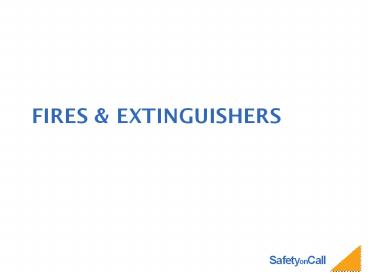Fires - PowerPoint PPT Presentation
1 / 14
Title: Fires
1
Fires extinguishers
2
What you will learn
- Types of Fires
- Fire Triangle
- Types of Extinguishers
- How to Use an Extinguisher
- Rules for Fires
3
Types of Fires
- Fires Are Classified by the type FUEL they burn.
- The 4 Types are
- A Wood, Paper, Plastic, Rags
- B Gasoline, Oil, Grease, Paint
- C Office Equipment, Motors, Switchgear, Heaters
- D Potassium, Sodium, Aluminum, Magnesium
4
Fire Triangle
- Fires Require
- Air (oxygen) Is required as a catalyst.
- Oxygen from the air or from the fuel itself.
- Fuel For a fire to start there must be something
to burn. - Heat For a fire to start there must be a hear or
ignition source.
5
Types of Extinguishers
- Type of fire extinguishers are classified by the
type fires on which they may be used.
6
Class A
- Used on Wood, Paper, Plastic
7
Class B
- Used on Flammable Liquid Fires
8
Class C
- Used on Electrical Fires
9
Class D
- Used on Metal Fires
10
Using A Fire Extinguisher
- Use the PASS System
- Pull
- The pin, this will allow you to discharge the
extinguisher. - Aim
- At the base of the fire.
- If you aim at the flames, the extinguishing agent
will fly right through and do no good. You want
to hit the fuel. - Squeeze
- The top handle or lever, this depresses a button
that releases the pressurized extinguishing agent
in the extinguisher. - Sweep
- From side to side until the fire is out
11
Rules for Fires
- Fires are very dangerous.
- Be certain that you will not endanger yourself or
others when attempting to put out a fire. - Pull the fire alarm.
- Call 911
- Assist anyone danger.
- Never fight a fire if you don't know what is
burning. - If you don't know what is burning, you don't know
what type of extinguisher to use.
12
Rules for fires (continued)
- Even if you have an ABC extinguisher, there may
be something in the fire which is going to
explode or produce highly toxic smoke. - Never fight a fire if the fire is spreading
rapidly beyond the spot where it started. - The time to use an extinguisher is in the
incipient, or beginning, stages of a fire. - If the fire is already spreading quickly, it is
best to simply evacuate the building, closing
doors and windows behind you as you leave.
13
Rules for fires (continued)
- Never Fight a fire if you don't have adequate or
appropriate equipment. - If you don't have the correct type or large
enough extinguisher, it is best not to try to
fight the fire. - Never fight a fire if you might inhale toxic
smoke. - If the fire is producing large amounts of smoke
that you would have to breathe in order to fight
it, it is best not to try. - Gases from man made materials can be fatal in
very small amounts.
14
Rules for fires (continued)
- Never fight a fire if your instincts tell you not
to. - If you are uncomfortable with the situation for
any reason, just let the fire department do their
job. - The final rule is to always position yourself
with an exit or means of escape at your back
before you attempt to use an extinguisher to put
out a fire. - In case the extinguisher malfunctions, or
something unexpected happens, you need to be able
to get out quickly, and you don't want to become
trapped. Just remember, always keep an exit at
your back.

